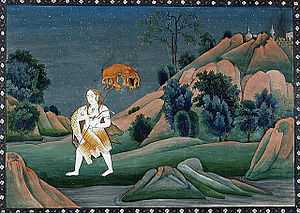Kottiyoor Vysakha Mahotsavam
| Kottiyoor Vysakha Mahotsavam | |
|---|---|
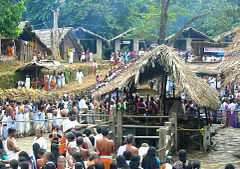 Kottiyoor Yajna bhoomi | |
| Official name | Vysakha Mahotsavam |
| Also called | Kottiyoor Utsavam |
| Observed by | Hindu |
| Type | Religious |
| Observances | Circumambulation of the Swayambhu linga, through the sacred pond(Thiruvanchira) |
| Begins | Swati in Saka Calendar:Vaisakha; (Gregorian Calendar: May–June) |
| Ends | Chitra in Saka Calendar:Jyaistha; (Gregorian Calendar:June–July) |
| 2014 date | 14 May - 6 July |
| Duration | 27 days |
| Related to | Daksha Yaga |
Kottiyoor Ulsavam or Kottiyoor Vysakha Mahotsavam (Sanskrit: वैशाख महोत्सव) is a 27-day yearly pilgrimage commemorating the Mythology of Daksha Yaga.[1] This is a pilgrimage observed by Hindus. The pilgrimage similar to the Kumbh Mela of Prayag as ablutions are performed. The Vysakha Mahotsavam is a yearly pilgrimage like the Sabarimala Pilgrimage of Hindus or Hajj Pilgrimage of Muslims, where in devotees go en masse to the shrine, from various places, in certain period of a year. The temple and the premises is also known as Dakshina Kasi.
In Kottiyoor (Kerala) there are two shrines on either banks of Vavali (Bavali) river, on the west bank it is the "Thruchherumana Vadakkeshwaram Temple" (called as 'Ikkare Kottiyoor Temple' by natives) which is a nalukettu temple complex and on the east bank there is a temporary shrine, where the festival ceremonies takes place, called "Akkare Kottiyoor" this is opened only during the Vyskha Mahotsavam. During the Vysakha pilgrimage, pooja is performed in a temporary temple (Ikkare Kottiyoor) in the same prehistoric Vedic environment. Only temporary hut thatches are made, these hermits are removed after the festival and no permanent constructions are made. Every year, thousands of pilgrims[2] come to the Yajna bhoomi.[3] Yajna shala has a Swayambhu Shivalinga, ablutions are performed on this shivalinga. Akkare Kottiyoor temple where the yajna takes place has no Sreekovil/Garbhagriha(Sanctum-sanctorium), instead it is located on a raised platform made of river stones named "Manithara" (മണിത്തറ). The premises is located on the center of a pond which is the origin of a Spring. From the pond water flows towards the Vavali river through west. The entire shrine looks like Shivalinga itself if viewed from the sky. This pond is called "Thiruvanchira"(തിരുവഞ്ചിറ). The devotees circumambulate the shrine within this pond, mostly in the rain. There is another raised circular platform beside the main shrine is called "Ammarakal Thara"(അമ്മാരക്കല്ല് തറ). There is a giant Jayanti vilakku (a type of Lakshmi lamp) and an idol covered by a palmyra leaf umbrella(ഓലക്കുട) there. It is believed that Sati devi immolating herself on "Ammarakal Thara".[4]
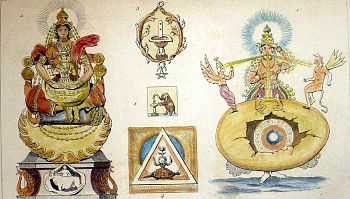
Ikkare Kottiyoor temple and Akkare Kottiyoor temple are dedicated Mahadeva. River Vavali flows in between the these shrines. The Ikkare Kottiyoor temple is believed to have been created by Parashurama whereas the Akkara kottiyoor temple is a Swayam bhu naturally formed. The system of rites and rituals of the temple were classified by Sankaracharya.
Period of Pilgrimage
The festival starts in the Swati Nakshatra of Saka Calendar month Vaisakha to Chitra Nakshatra of Jyaistha Month. This is equavalent to the months in Malayalam calendar Medam-Edavam to Edavam-Mithunam or the months in Gregorian calendar May–June to June–July. The time of pilgrimage is the monsoon season where there is abundant rain in the region. The Vavali river will be gushing with water suitable for ablutions. Also the sacred pond Tiruvanchira will be filled with water. The climate in the time of pilgrimage is pleasant or slightly cold.[5] Even though the pilgrimage is called as Kottiyoor Ulsavam or Kottiyoor Festival the programs related to the pilgrimage is only religious rituals. Only Vedic hymns are recited and priestly rites and rituals are performed here. There could be a misunderstanding in hearing the term 'festival', but there will be no entertainment programs like the festivals in other temples, the only objective is pilgrimage.
Mythology
The mythological story of Daksha Yaga[6] has immense influence in Shaivism, Shaktism literatures. Innumerable mythologies were derived or resulted as an epilogue of this mythology, The origin of Shakti Peethas, Marriage of Shiva and ShreeParvati resulting in the birth of Ganesh and Subrahmanya, the story about the death of Kamadeva are few among them.
Daksha was one of the Prajapati, Son Brahma and one among his foremost creations. The name Daksha means ‘Skilled one’. Daksha had two wives Prasoothi and Panchajani (Virini). Sati (also known as ‘‘Uma’’) was his youngest daughter born from Prasoothi (the daughter of the Prajapati Manu), she was the pet child of Daksha and he always carried her along with him. Sati, the name means the feminine of Sat (‘The truth’).[7] She is called Dakshayani as she followed Daksha’s path, this is derived from Sanskrit words Daksha and Ayana(Walk or Path).[8][9]
The mythology is mainly told in the Vaayu Purana. It is also mentioned in the Kasi Kanda of the Skanda Purana, the Kurma Purana, Harivamsa Purana and Padma Purana. Linga Purana, Shiva Purana and Matsya Purana also narrates the incident. Additional reference about Puranic texts on Daksha Yaga and alternate versions of the epilogue of the mythology are given in Notes section in the end of article. [upper-alpha 1]
Sati-Shiva Marriage
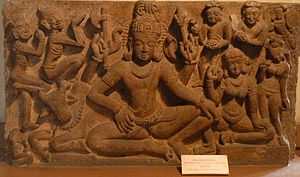
Sati, the youngest daughter of Daksha,[9] was in deep love with Shiva and wished to become his wife. Her worship and devotion towards Shiva, strengthened the immense desire in her to become his better half. However Daksha did not like his daughter’s contemplation towards Shiva, mainly because Daksha is a Prajapati, the Emperor of dakshina desa of Aryavarta (ancient Indian region (comprising Afghanistan, Pakistan, India, Nepal, Bangladesh) following the Aryan culture), and the son of Brahma deva; and Sati, the Emperor's daughter, apparently the royal princess. They were wealthy nobility and their imperial royal lifestyle was entirely different from that of Shiva. Daksha as an Emperor wanted to increase his influence and power by having marriage alliances with powerful empires and influential Sages and Adityas(Gods).[7]
Shiva on the other hand led a very modest life. He lived among the downtrodden, wore a tiger skin, he smeared ashes on his body, he had thick locks of matted hair, he begged with a skull as bowl, his abode is Mount Kailasa in the freezing cold Himalayas where only mountains, rocks and snow were present. He embraced all kind of living being and did not keep any distinction between good soul and bad soul, the Bhutaganas’ (assembly of heads of clans), his followers, consisted of all kinds of ghosts, demons, ghouls and goblins. He wandered though garden and graveyard alike.[12]
Daksha hence had aversion towards Shiva in being his daughter’s companion. However unlike Daksha, Sati Devi loved Shiva as she had the revelation that Shiva, the Supreme Rudra is in fact The Mahadev, or The Paramashwara (The Supreme Almighty-Parabrahma) itself.[7][13]
When his daughters’ grew up, Daksha conducted a Swayamvara yagam. Swayamvara was an ancient kind of marriage, where the woman gets the authority to choose her husband from the prospective proposals. Sati undoubtedly chose Shiva. The marriage ceremony of Sati and Shiva was conducted. Daksha was forced to accept Shiva as his son-in-law, as he could not influence the groom selection process.
- Brahma's Yaga
Once Brahma dev Daksha’s father conducted a huge yaga, all the Prajapathi around the world and all the Adityas, Kings were called upon by Brahma for the yaga. Shiva and Sati were also called to participate in the yaga. All of them came for the yaga and sat in the ceremonial place. Daksha came last. When he came all of them in the yaga stood up in reverence for him as he was one of the Prajapati, but Brahma, Shiva and Sati Devi did not stand when Daksha came to the yaga shala.[14]
It was a worldwide ceremony where in all the emperors, kings and revered people around the world were present so strict adherence in etiquette was mandatory. Brahma Dev did not stand as he was Daksha’s father. Sati did not stand as she can only follow what her husband does.
Shiva was following the cultural etiquette of a son-in-law. According to the culture Son-in-Law is the one who is the guardian of a man's daughter; a highly respected stature. The culture is that once a girl is married to a man the girl moves out of her Gotra(race) and joins her husband's Gotra. The couple is then considered as outsiders to the girl's family.[15] Daksha is the son of the yaga host, Brahma deva; which apparently makes Daksha the host himself. A prevalent culture in the region is that, for welcoming an incoming guest, hosts stand up and receive him i.e. the guest need not have to stand up and welcome an inmate in inmate's home. However this dogma is little complex; depending on the situation, a guest can stand up to show his reverence if where in host is of a high stature than the guest, e.g. if the guest is a King; however this rule never applies to the guest's son-in-law as what ever gestures he make, it will become quite obvious when compared to other guests; i.e. in this mythology the gestures of guests such as Indra or Agni dev will not be specifically observed but the gestures of Shiva will be pin pointed as everyone knows he is the son-in-law of the guest.
Shiva was a guest of Daksha, and if he stood up, it would be like Shiva, the son-in-law welcoming his father-in-law in his wife's home i.e. if Shiva stood up he is indirectly proclaiming that he is an inmate of his wife's house, in-front of the whole world, which is culturally considered as one of the worst social status, a man and his family can possess. So Shiva sat in his chair itself when Daksha came, in order to comply with the etiquette formalities. It was not only to guard his and his Gotra's prestige but also Daksha's prestige in-front of the world. Shiva know that, Daksha being an Emperor will get insulted in front of the entire world in making his son-in-law as his house member, it will be a disgrace to Sati too. But Daksha, the pompous Emperor, misunderstood Shiva’s gesture. He thought Shiva was insulting him by not paying respect towards him. He vowed to take revenge on the insult in the same manner.[9]
The Daksha Yaga
Daksha’s grudge towards Shiva compounded after these incidents. As a prime motive to insult Shiva, Daksha started a great yaga similar the yaga conducted by Brahma. The Yaga was to be presided by Sage Bhrigu. He invited all the Adityas(Gods), Prajapatis’ and Kings to attend the yaga and intentionally avoided inviting Shiva and Sati.[9][14]
- Dadhichi-Daksha Argument
The Kurma Purana discusses the dialogues between Dadhichi[upper-alpha 2]and Daksha. After the sacrifice and hymns where offered to the 12 Adiyas; Dadhichi one of the most sacred of the sages notices that there is no sacrificial portion (Havvis) allotted to Mahadeva and to his wife and no vedic hymns are used in the Yaga addressing Rudra which where part of Vedic hymns. He warned Daksha that he should not alter the Holy Vedas for personal reasons. The priests and sages also supported what Dadichi said. Daksha replied to Dadichi that he will not do so and abused Shiva. Dadhichi left the yaga due to this argument.[6]
- Sati's entry to the ceremony
Sati came to know about the grand yagnja organized by her father. She requested Shiva to attend the yaga. Shiva refused her request saying that it is not well-mannered way in attending an uninvited function. He reminded her that she is now his wife more than Daksha’s daughter and so after marriage she is a member of Shiva’s family of rather than Daksha’s. The feeling of personal bondage with her parents overpowered the social etiquette she had to follow. She even had a notion that there is no need to invite her because she is Daksha’s pet daughter and no formality existed between them. She consistently pleaded and urged to Shiva to let her go and attend the ceremony, and became adamant in her demand without listening to the reasons Shiva told for not attending the function. He allowed Sati to go to her parents, along with Nandi, and attend the ceremony, but Shiva himself did not go along with her.[13]
Upon reaching Sati tried to meet her parents and sisters, Daksha was arrogant and avoided to interact with Sati. He repeatedly snubbed her in front of all the dignitaries but Sati maintained her composure. Upon Sati’s persistent urge to interact, Daksha reacted vehemently, he insulted her in front of all others in coming to the ceremony in which she has not been invited. He called Shiva atheist and cremation ground dweller. As planned he took advantage of the situation he continued shouting repugnant words against Shiva. Sati fell in deep remorse in not listening to her beloved husband, Daksha’s disdain towards her and especially towards her dearly loved Shiva in front of the entire people was growing each instant she stood there. The shameless insult and humiliation on her and her beloved eventually became too unbearable for her.[7][17]
She cursed Daksha for doing such atrocious act towards his innocent child and her well respected husband and reminded him that his haughty behavior had blinded his intellect. She cursed him that the wrath of Shiva will destroy him and his empire. Sati unable to bear further humiliation, committed suicide by jumping into the sacrificial fire. The beloved daughter of the entire race was engulfed in fire.[6][7][14]
The onlookers around tried to save Sati but it was too late.[9] They were only able to find the half burnt body of Sati. She was no more. The most loved progeny of Daksha's race who was the source of their happiness of their rece faded away like a gleam to satisfy her father's pride. Daksha's pride being a Prajapati and prejudice against his son-in-law created amass hatred within himself, which resulted in the death of his daughter.[7][13]
The Nandi and the accompanied bhootas went out of the yaga place after the incident. Nandi curses the participants and Bhrigu reacted by cursing the Bhootaganas back.
The wrath of Shiva
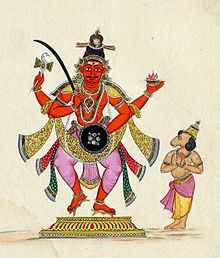
Shiva went in deep pang upon hearing the shocking death of his wife. His sadness and grief grew into terrible anger when he realized how Daksha viciously plotted a treachery on Shiva and it was his innocent wife who fell into the trap instead of him. Shiva came to know about Daksha’s callous behavior towards Sati. Even though Sati was once his favorite daughter; in order to satisfy his ego and pride he forced Sati to die dishonorably. Shiva rage became so aggravated that he plucked a lock of hair from his head and smashed it on the ground, breaking it into two with his leg. Armed and frightening Veerabhadra and Bhadrakali[9] (Invocation Bhadrakali along with Veerabhadra mentioned in Vayu Purana) emerged from that. Shiva ordered them to kill Daksha and destroy the yaga.[13]
The ferocious Veerabhadra and Bhadrakali along with the Butaganas’ marched south and waged a terrible assault on Daksha. Daksha’s army was swiftly and brutally crushed and slaughtered and they started destroying the yaga surroundings, like a hurricane entering a city, people renounced the yaga and started running away from the turmoil. Sage Bhrigu created an army with his divine penance powers to resist Shiva’s attack and protect the yaga. Bhrigu’s army was not able to bear the brunt, they were demolished and the entire premises were ravaged. All those who participated even the Prajapathis and Adityas(Gods) were mercilessly beaten, wounded or even slaughtered. Daksha was caught and decapitated, the attack culminated when the Bhutaganas started plucking out Sage Bhrigu’s white beard as a victory souvenir.[7][13]
According to the Shaiva and Vaishnava Puranas the mythology of Daksha Yaga ends here. The rest of the mythology is the epilogue of story of Daksha Yaga mentioned in Shakta Puranas like Devi Bhagavatha Purana, Kalika Purana and the folklores of various regions. The one following is a Shaiva version. The Vaishnava versions are also mentioned in the Notes section.
The sorrow of Shiva
The sacrificial ceremony of this extent, the yagna, was obstructed and desolated. As the obstruction of yaga will create havoc and severe ill effects on the nature, Brahma and Vishnu went to call the grief-stricken Shiva to the location of yaga. They comforted and showed their sympathy towards Shiva. They requested him to come to the yaga location and pacify the bhutagana s’ and allow the yaga to be completed. Shiva agreed and the Trimurthy together came to the site. Shiva found the burnt body of his wife. In the poignant surroundings, the world was saddened when they saw the heartbreaking sorrow of Shiva. Vishnu went and embraced his beloved friend Shiva and comforted him. Shiva gave permission to continue yaga. Daksha was absolved by Shiva and the head of the Ram(Male goat) meant for yaga was fixed on the decapitated body of Daksha and gave his life back. The yaga or yagnjam was completed successfully.[18]
Shiva was so distressed and could not part from his beloved wife. He took the dead body of Sati and wandered around the land. The parts of Sati’s dead body fell on the places Shiva wandered. These places commemorating each body part came to be known as The Shakti peethas. There are 51 Shakti peethas, representing the 51 alphabets of Sanskrit.[18] Shiva went to isolation and solitude for ages and wandered all around until Sati devi took birth as Shri Parvati as the daughter of the King Himavana. Parvati took penance and gave away all her royal privileges and went to forest She then came to be known as ‘‘Aparna’’ the one without sustenance. Shiva tested her affection and devotion in disguise and even persuaded her to go away by telling downbeat impression about Shiva, but Parvati’s contemplation towards Shiva was so strong, Shiva himself could not deter her. He eventually realized Parvati is Uma or Sati herself. Shiva later on married Shri Parvati as Sundareshwara.[7][18]
Shakti Peethas
The mythology of Daksha Yaga is considered as the story of origin of Shakti Peethas. Shakti Peethas are sacred abode of Devi. These shrines are located all over South Asia. Most of the temples are located in India and Bangladesh there are few shrines in Pakistan, Nepal and Sri Lanka. There are 51 Shakti Peethas as per the puranas (denoting the 51 Sanskrit alphabets),[19] however 52, 108 number are also been believed. Shakti Peethas are the revered temples of the Shakta (Shaktism) sect of Hinduism. It is said that the body part of the corpse of Sati Devi fell in these places and the shrines are mostly know associated by the name of the body part. Out of the 51 Shakti peethas, 18 are said to be Maha Shakti peethas. They are Sharada Peetham (Saraswati devi), Varanasi Peetham (Vishalakshi devi), Gaya Peetham (Sarvamangala devi), Jwalamukhi Peetham (Vaishnavi devi), Prayaga Peetham (Madhaveswari devi), Kamarupa Peetham (Kamakhyadevi), Draksharama Peetham (Manikyamba devi),[20] Oddyana Peetha (Girija(Viraja) devi), Pushkarini Peetham (Puruhutika devi), Ujjaini Peetham (Mahakali devi), Ekaveera Peetham[21] (Renuka Devi), Shri Peetham (Mahalakshmi devi),[22] Shrishaila Peetham (Bhramaramba devi), Yogini Peetham (Yogaamba(Jogulamba) devi),[23] Krounja Peetham (Chamundeshwari devi), Pradyumna Peetham (Shrinkala devi),[24] Kanchi Kamakodi Peetham (Kamakshi devi), Lanka Peetham (Shankari devi).[25]
The Vaishakha Festival Rituals
The Kottiyoor Vysakha Mahotsavam (Tamil: கோட்டியூர் வைசாக மகோற்சவம்)(Hindi: कोट्टीयुर वैशाख महोत्सव) (Malayalam: കൊട്ടിയൂർ വൈശാഖ മഹോത്സവം)The festival rites are performed by Ikkare Kottiyoor temple on the west bank of Vavali river.[26]
Kottiyoor Ulsavam is conducted within the Tiruvanchira pond in rainy season where only hay thatched hermits are allowed. The sacred pond formed as it is the origin of a Spring and a tributory path of Vavali river. The environment gives an appeal of reaching in ancient vedic ages. Kottiyoor itself is a serene hilly area. It is believed that Bhutaganas bring the materials needed for the rituals from the Tirunelli MahaVishnu Temple (10 km south of Kottiyoor Temple) through the Brahmagiri valley. Kottiyoor Temple as its name says is the meeting of the Trimurthy-Brahma, Vishnu and Shiva. The Shivalinga of the Kottiyoor Temple is Swayam bhu i.e. formed naturally. Kottiyoor Temple pilgrimage is a rare temple where all communities of the society participate where in each community is given right to perform specific duties for the pilgrimage. The Swayambhu linga was found by the aborigin tribes of the area and was informed to the priest family near by and the Kottiyoor temple was renovated. These are legends and there is no specific date for the incident. The pilgrimage to Kottiyoor is happening for centuries.[27]
The ceremonies for the Kottiyoou Festival, performed in sequential order, are
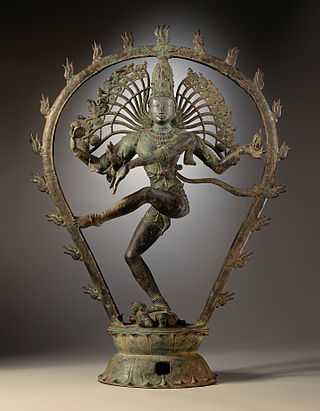
PurakkuvamMalayalam: പുരക്കുവം(പ്രാക്കുഴം, NeerezhunnallathuMalayalam: നീരെഴുന്നെള്ളത്, VavalikettuMalayalam: വാവലിക്കെട്ട്, Neyyattam Malayalam: നെയ്യാട്ടം, Bringing Agni and Ooda (Reed)Malayalam: ഓടയും അഗ്നിയും എഴുന്നെള്ളത്, "Vaal” EzhunnallathuMalayalam: വാൾ എഴുന്നള്ളത്, “Chothi Vilakku”Malayalam: ചോതിവിളക്ക്, “Naallam Thurakkal” Malayalam: നാളം തുറക്കൽ, “Bhandaram Ezhunnallathu” Malayalam: ഭണ്ഡാരം എഴുന്നെള്ളത്, Thiruvona Aaraadhana Malayalam: തിരുവോണ ആരാധന, Ilaneervaipu Malayalam: ഇളനീർ വെയ്പ്പ്, Ilaneerattam Malayalam: ഇളനീരാട്ടം, Revathi Aaraadhana Malayalam: രേവതി ആരാധന, Rohini Aaraadhana Malayalam: രോഹിണി ആരാധന, Thrikur Ariyalavu Malayalam: തൃക്കൂർ അരി അളവ്, Makam Malayalam: മകം, Kalam Varavu Malayalam: കളം വരവ്, Atham naal Malayalam: അത്തം നാൾ, Vallattom Malayalam: വാളാട്ടം, Thengaeru Malayalam: തേങ്ങ ഏറു, Chithra naal Malayalam: ചിത്ര നാൾ, Thrikkaleshattam Malayalam: തൃക്കലശാട്ടം, Thandilmeil Oonu Malayalam: തണ്ടിന്മേൽ ഒന്നു, Vaal madakkam Malayalam: വാൾ മടക്കം, Valiya Vattalam Payasam Malayalam: വലിയ വട്ടളം പായസം, Purakkuvam (Prakuzham, Purakuzham)Malayalam: പുരക്കുവം (പ്രാക്കുഴം, പുരക്കുഴം)
Rohini aradhana is an important ceremony Kurumathoor Nayikan Brahman the title name of the head of a vaishnavite family in the area, who has the birthright for the ceremony, performs the rite. He is considered as a representation of Vishnu. The Namboothiri performs the rites and embraces the Swayambhu Shivalinga, i.e. Alingana Pushpanjali. This is to commemorate the incident during the Daksha yaga. Shiva was in heartbreaking sorrow, when he saw the burned dead body of his beloved wife Sati (goddess). Rohini aradhana, is to remind how Vishnu embraced Shiva to pacify and comfort his dear mate.
Entry of Parashurama
Ages after the dreadful incident and havoc, carrying Sati Devi's tears and curse, the land started being governed by Kali (the personification of Kali Yuga, the reigning power of calamity). Kerala went submerged under water. Parashurama who donated all his conquered land to Brahmins needed a place to live. So upon requesting Varuna, he threw his axe from Gokarna to Kanyakumari and Kerala reemerged from the sea. Parashurama was attacked by Kali in Kottiyoor. He overpowered Kali and as he raised his axe to kill Kali the Trimurthi materialised there and stopped Parashurama. He released Kali in a condition that he will never ever come in the premises of the swyam bhuu linga of his Guru, Shiva, in Kottiyoor. He started the festival of 27 days in remembrance of the early incidents that happened in the place.[28]
Exclusiveness in rites
- Usha pooja is only for 24 days; to match with the standard yaga period. However the rest of the pooja is conducted for all 27 days.
- The quantity of 'Nivedyam' is fixed as in ancient time. It not increased proportional to the increase in pilgrims.
- No pooja is performed at 'Ammarakkal'(Sati Devi's suicide site) only pushpanjali and nivedyam is offered.
- Punyaham is never performed, as the location is blessed with the congruence of the Shaiva, Shakta, Vaishnava divinities, Kottiyoor is so pure so that all impurities vanishes away in there. The location is an origin of spring and a path of Vavali river and the festival is in rainy season.
- Ganapathi homam is pedformed every day in morning.
- The whole premises is a temporary shelter and it is a replica of the ancient Vedic worship and culture, thousands of years ago. Which means unlike most of the pilgrimage there is no permanent temple structure. The pradakshinam (circumambualtion)is through a pond.

How to reach
The nearest railway station is Thalassery, however the Kannur railway station can be chosen for pilgrims from north and Kozhikode or Vadakara railway stations for pilgrims from south. There are regular bus services during the Mahotsavam period in short intervals and also there are bus services throughout the year to Kottiyoor. The nearest air port is Kozhikkode.
See also
- Virabhadra-Daksha
- Shaivism-Shaktism
- Shiva-Sati-Shakti Peethas
- Kottiyoor, Thalassery, Kerala
- Kottiyoor Vadakkeshwaram Temple-Tirunelli Temple
Notes on various Puranic references on Daksha Yaga
- ↑ The mythology is derived from the ancient Sanskrit texts called Puranas.
- The mythology of Daksha Yaga is mainly from the Vaayu Purana. There is also description about the mythology in Padma Purana, Skanda Purana, Kurma Purana, Harivamsa Purana, Matsya Purana, Linga Purana, Shiva Purana in the perspective of Shaiva Vaishnava philosophies. Puranas which are more inclined to Vaishnavism are Vaishnava similarly there are Shaiva and Shakta Puranas.
- The Vaayu Purana mentions the invoking of Bhadrakali and addresses her also as Rudrakali.
- The Vaayu Purana do not mentions about the decapitation of Daksha instead it saya Yagnja the personification of Yaga took the form of an antelope and jumped towards the sky, Veerabhadra captured it and decapitated Yagnja. But Linga Purana and Bhagavatha Purana mentions about the decapitation of Daksha[6]
- Vaayu Purana mentions about the attack of Bhutaganas, the nose of some goddesses were cut, breaking Yama Deva's staff bone, Pulling out Mitras eyes, Indra trampled by Veerabhadra and Bhutaganas, Pusha's teeth knocked down, Chandra Deva was beaten heavily, all of the Prajapathis' were beaten, the hands of Vahini were cutoff, Bhrigu's beard been cutoff.[6]
- Certain other puranas like Harivamsa, Kurma, Skanda narrates the story in the perspective of the Vishnava-Shaiva community enmity prevalent in olden times. Here there are combats between Vishnu and Shiva or Veerabhadra and in these Puranas some time the former or the latter wins
- In Vaayu Purana Daksha is not decapitated as said before instead he begs mercy from the Parabrahma ,(The Supreme Almighty who is formless) who rose from the Yagna fire and forgives Daksha. The Parabharma informs Daksha that Shiva is infact a manifestation of Parabrahma. Daksha then becomes a great devotee of Shiva.
- The story of Daksha Yaga in Vaishnava and Shaiva puranas ends with the surrendering of Daksha to the Parabrahma or until the destruction of Yaga and decapitation of Daksha in various puranas.[6]
- The Epilogue of the mythology is the creation of Shakti Peethas. This epilogue is usually been told along with the story of Daksha Yaga by Shakta sect of Hinduism. There are two different versions of the formation of Shakti Peethas in post puranic texts or regional stories the Vaishnava version says Vishnu cut the corpse of Sati Devi using sudarshana chakra to pacify Shiva the Shaiva version says the parts were fallen while Shiva was carrying the corpse of Sati in various places. Both the versions has a common end which says the places where these body parts fell came to be known as Shakti Peethas. The Shakti Peethas are mentioned in Shakta(Shaktism) Puranas like Devi Bhagavatha Purana, Kalika Purana. Some of the puranas which came in later ages gave more importance to their supreme deity (depending on Vaishnava, Shaiva and Shakta sects) in their literature.[10][11]
- Various locations: In additional to Kottiyoor two other shrines believe their respective place as a location as the site of Daksha Yaga they are Kanakhala near Haridwar in Himachal Pradesh and Draksharamam in Andhra Pradesh. Kanakhala and Draksharamam are temples and Kottiyoor Vysakha Mohotsavam is a 27 day, yearly pilgrimage(entry is prohibited for the rest of the year).
- ↑ Sage Dadhichi is an embodiment of self sacrifice, as mentioned in Puranas. Indra was able to make Vajrayudha using the Sage's ribs and vanquish Vritra.[16]
References
| Wikisource has original text related to this article: |
- ↑ "Daksha Yagnam". The Hindu. Aug 19, 2009. Retrieved 2013-07-20.
- ↑ "Thousands throng Kottiyur temple". The Hindu. Jun 7, 2005. Retrieved 19 August 2013.
- ↑ "Huge crowd at Kottiyur temple". The Hindu. Jun 17, 2006. Retrieved 19 August 2013.
- ↑ "Few Facts about the temple". Kottiyoor Devaswom. Retrieved 11 August 2013.
- ↑ "Kottiyoor Shiva Temple". touristplaces.org. Retrieved 13 August 2013.
- ↑ 6.0 6.1 6.2 6.3 6.4 6.5 "Vaayu Purana". Horace Hayman Wilson. pp. 62–69. Retrieved 12 August 2013.
- ↑ 7.0 7.1 7.2 7.3 7.4 7.5 7.6 7.7 Ramesh Menon (2011). Siva: The Siva Purana Retold (1, Fourth Re-print edition ed.). Rupa and Co. ISBN 812911495X.
- ↑ "The list of Hindu sacred books". John Bruno Hare. 2010. Retrieved 2013-07-23.
- ↑ 9.0 9.1 9.2 9.3 9.4 9.5 Skanda Purana (Pre-historic Sanskrtit literature), G. V. TAGARE (Author),; Ganesh Vasudeo Tagare (Translator) (August 1, 1992). G.P. Bhatt, ed. Skanda-Purana, Part 1 (1 ed.). Motilal Banarsidass. ISBN 8120809661.
- ↑ "What are Puranas? Are they Myths?". boloji.com. Retrieved 12 August 2013.
- ↑ Wendy Doniger, ed. (1993). Purana Perennis: Reciprocity and Transformation in Hindu and Jaina Texts. State University of New York Press. ISBN 9780791413814.
- ↑ "If one is hurt by the arrows of an enemy, one is not as aggrieved as when cut by the unkind words of a relative, for such grief continues to rend one's heart day and night". Naturallyyoga.com. Retrieved 2014-02-17.
- ↑ 13.0 13.1 13.2 13.3 13.4 "Essence Of Maha Bhagavatha Purana". Shri Kanchi Kamakoti Peetham. Retrieved 2013-07-23.
- ↑ 14.0 14.1 14.2 "ഇതു ദക്ഷ യാഗ ഭൂമി". Malayala Manorama. 2013. Retrieved 2013-07-23.
- ↑ "Samskaras the sacrament of Hinduism-The role of women". Hinduwebsite.com. Retrieved 2014-02-17.
- ↑ "The story of Sage Dadhichi and Vajrayudha". Hindu=-blog.com. Retrieved 19 August 2013.
- ↑ "Lord Shiva stories, Shiva purana". Sivaporana.blogspot.in. 2009. Retrieved 2013-07-23.
- ↑ 18.0 18.1 18.2 (Translator), Swami Vijnanananda (2007). The Srimad Devi Bhagavatam. Munshiram Maniharlal. ISBN 8121505917.
- ↑ Roger Housden (1996). Travels Through Sacred India (1 ed.). Thorsons. ISBN 1855384973.
- ↑ "Manikyamba devi, Draksharamam (Andhra Pradesh)". specialyatra.com. Retrieved 2 August 2013.
- ↑ "18 Shakti peethas". shaktipeethas.org. Retrieved 2 August 2013.
- ↑ "Mahalakshmi Temple Kolapur". mahalaxmikolhapur.com. 2010. Retrieved 2 August 2013.
- ↑ "Jogulamba Temple, Alampur". hoparoundindia.com. Retrieved 2 August 2013.
- ↑ "Travel Guru: Ashta Dasha Shakti Peethas (Shankari devi, Kamakshi Devi, Srigala Devi, Chamundeshwari devi, Jogulamba devi, Bhramaramba devi, Mahalakshmi devi, Ekaveerika Devi, Mahakali devi, Puruhutika devi, Girija Devi, Manikyamba devi, Kamarupa devi, Madhaveswari devi, Vaishnavi devi, Sarvamangala devi, Vishalakshi devi, Saraswathi devi)". Badatravelguru.blogspot.in. Retrieved 2014-02-17.
- ↑ E. Alan Morinis (1984). Pilgrimage in the Hindu Tradition: A Case Study of West Bengal. US: Oxford University South Asian studies series, Oxford University Press. ISBN 0195614127.
- ↑ "Kottiyoor Devaswam Temple Administration Portal". Kottiyoordevaswom.com. Retrieved 20 July 2013.
- ↑ "New Kottiyoor". Kottiyoodevaswom.com. Retrieved 11 August 2013.
- ↑ "Parashurama’s entry". Kottiyoordevaswom.com. Retrieved 11 August 2013.
Bibliography of notable offline sources
- Ancient Indian Tradition and Mythology: Mahapuranas-The Vayu Purana. UNESCO Heritage Publishing, (United Nations Organization). 1987. ISBN 9231030175.
- (Translator), H.H Wilson (November 4, 2008). The Vishnu Purana - Vol I. Hesperides Press. ISBN 1443722634.
- Ramesh Menon (2011). Siva: The Siva Purana Retold (1, Fourth Re-print edition ed.). Rupa and Co. ISBN 812911495X.
- (Translator), F. Max Muller (July 26, 2004). The Upanishads Part II: The Sacred Books of the East Part Fifteen. Kessinger Publishing, LLC. ISBN 1417930160.
- (Translator), Swami Vijnanananda (2007). The Srimad Devi Bhagavatam. Munshiram Maniharlal. ISBN 8121505917.
- Dallapiccola, Anna L (2002). Dictionary of Hindu Lore and Legend. Thames & Hudson. ISBN 0500510881.
Further reading
| Wikimedia Commons has media related to Kottiyoor Vysakha Mahotsavam. |
- (Translator), H.H Wilson (January 31, 2003). Select Works Of Sri Sankaracharya: Sanskrit Text And English Translation. Cosmo Publishing. ISBN 8177557459.
- (Translator), F. Max Muller (June 1, 2004). The Upanishads, Vol I. Kessinger Publishing, LLC. ISBN 1419186418.
| |||||||||||||||||||||
| |||||||||||||||||||||||||||||||||||||||||
| |||||||||||||||||||||||||
| |||||||||||||||||||||||||

